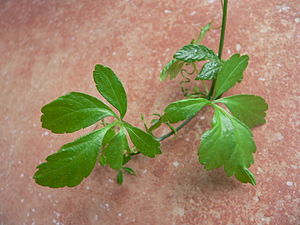Difference between revisions of "Gynostemma pentaphyllum"
Jump to navigation
Jump to search
(I've eaten this) |
(start article) |
||
| Line 16: | Line 16: | ||
|binomial_authority = ([[Thunb.]]) [[Makino Tomitaro|Makino]] 1902 | |binomial_authority = ([[Thunb.]]) [[Makino Tomitaro|Makino]] 1902 | ||
|}} | |}} | ||
| + | |||
| + | '''Jiaogulan''' (''Gynostemma pentaphyllum'') is unusual for a cucurbit in that its fruits have no commercial value and are considered inedible, and instead its leaves are used to brew tea. Gynostemma tea is purported to have a variety of health benefits. Its taste is similar to that of green tea, but with a non-sugar-like sweetness similar to that of [[Stevia]]. | ||
{{Ack-Wikipedia}} | {{Ack-Wikipedia}} | ||
Latest revision as of 02:35, 23 November 2017
| Gynostemma pentaphyllum | |
|---|---|

| |
| Scientific classification | |
| Kingdom: | |
| (unranked): | |
| (unranked): | |
| (unranked): | |
| Order: | |
| Family: | |
| Subfamily: | Nhandiroboideae (syn. Zanonioideae)
|
| Tribe: | Zanonieae
|
| Subtribe: | Gomphogyninae
|
| Genus: | |
| Species: | G. pentaphyllum
|
| Binomial name | |
| Gynostemma pentaphyllum | |
Jiaogulan (Gynostemma pentaphyllum) is unusual for a cucurbit in that its fruits have no commercial value and are considered inedible, and instead its leaves are used to brew tea. Gynostemma tea is purported to have a variety of health benefits. Its taste is similar to that of green tea, but with a non-sugar-like sweetness similar to that of Stevia.
Acknowledgements
This article uses material from the Wikipedia article Gynostemma pentaphyllum, which is released under the Creative Commons Attribution-Share-Alike License 3.0.